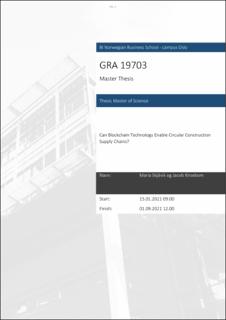| dc.description.abstract | Circular economy (CE) practices have gained more attention as it has become increasingly important to focus on environmental practices for supply chains. As one of the largest industry sectors in Norway, the construction industry accounts for approximately 40 percent of the country's extracted resources- and yearly produced waste. It can therefore be argued that reducing wastage by incorporating circular practices is highly important. However, in order to transition to CE business models such as circular construction supply chains (CCSC), it is crucial with supply chain visibility. This is problematic for the construction industry as supply chains are characterised as being fragmented and complex, and the industry suffers from low levels of digitalization compared to other industries. However, digitalization could provide increased visibility and thereby aid the transition to CCSC.
Therefore, in this master thesis, we wanted to study blockchain technology (BCT) as one of the main characteristics is to provide transparency and traceability. BCT is a relatively new technology we wanted to study the potential the technology offers in the enablement of CCSC. We have therefore conducted a qualitative study with expert interviews to increase understanding of how BCT could aid the construction industry in becoming a part of the CE. Based on this, our research question is; How can blockchain technology enable circular construction supply chains through increased supply chain visibility? In order to answer this research question, we first examined the current industry situation with regards to CE practises, supply chain visibility, and the level of digitalization. Following this, we studied the drivers, conditions and barriers for BCT adoption towards CCSC.
Our study shows that the most efficient way to use BCT to enable CCSC, is to exploit the technology's ability to create material passports through digital tokens, and smart contracts with incentive systems. The technology could provide the supply chain with increased visibility, in addition to further incentivising actors to employ CE practices. The potential of the technology to aid CCSC is interesting, however, we the study concludes with the fact that BCT is still premature. It would therefore be interesting to further investigate the potential application for the construction industry, and conduct use-cases to prove the relevance for companies and supply chains. | en_US |
